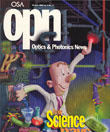
October 1998 Issue
Feature Articles
The Economics of Science: From Photons to Products
The paradigm of the large industrial laboratory is fading. This article looks at the optoelectronics industry and suggests that new technologies with economic impact will be created from effective networks of large and small enterprises coupled with university centers of innovation.
by Lional C. KimerlingUniversity Technology Transfer Through Licensing
SINCE 1980, UNIVERSITIES AND COMPANIES HAVE BEEN WORKING TOGETHER TO TRANSFER TECHNOLOGY FROM THE LAB TO THE MARKETPLACE. HERE'S A GENERAL OVERVIEW AND AN EXAMPLE OF STANFORD UNIVERSITY'S APPROACH.
by Ian SprouiiHow to Find Federal Funding for Optics R&D
The key to obtaining federal funding for R&D is knowing where to look and who to contact. Learn tips from agency insiders on how to secure support and how several agencies and funding programs approach funding.
by Susan M. ReissBringing AO Online
Most OSA members know that their Society aggressively pursues electronic means of publishing and that this effort has resulted in a wide array of electronic publications including an annual CD-ROM containing a year of journal articles, the OpticsNet Web page, electronic submissions, the Optics Express online journal, and online versions of the print journals. What most members do not know is how these electronic publications come into being. This column examines the process of bringing one of those publications, Applied Optics Online, to your screen.
by Deborah HerrinEvanescent Coupling, Part 2
Last month we began a discussion of electromagnetic coupling between objects that are close enough to sense each other's evanescent fields without making physical contact. This subject has received widespread attention in recent years as manufacturers of optical data storage systems have attempted to increase recording densities by flying a solid immersion lens over the surface of a magnetooptical disk, taking advantage of the evanescent coupling of a focused laser beam into and out of the disk. This month's column is devoted to a description of magneto-optical disks, in general, and the nature of their interaction with the solid immersion lens, in particular.
by Masud MansuripurApochromatic Telephoto Lens with a Diffractive Element
In order to achromatize an optical system at more than two wavelengths, it is necessary that at least one of the optical materials deviate from the linear approximation.
by J. Brian CaldwellSome Common Color Fallacies
Our perception of color is affected by adjacent colors: a patch of orange surrounded by red looks yellow; orange surrounded by yellow looks red. Color perception is also affected by the nature of the illumination, by more distant colors in the field of view, and by colors recently seen.
by Kurt Nassau
![Illustration of optical skyrmions. [Y. Shen]](https://opnmedia.blob.core.windows.net/$web/opn/media/images/articles/2025/0525/departments/202505-cover-web.jpg?ext=.jpg)
![Illustration of a synapse in the brain. [Getty Images]](https://opnmedia.blob.core.windows.net/$web/opn/media/images/articles/2025/0425/departments/202504-cover-web.jpg?ext=.jpg)
![Fiber draped around a hand, demonstrating its flexibility. [Photo by Z. Wang and L. Wei]](https://opnmedia.blob.core.windows.net/$web/opn/media/images/articles/2025/0325/departments/202503-cover-web.jpg?ext=.jpg)